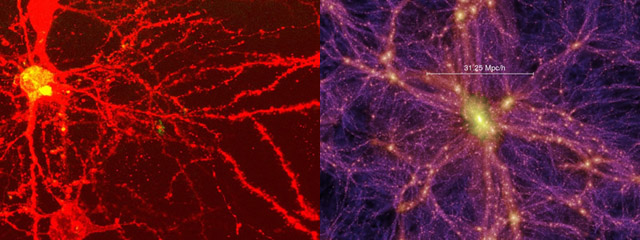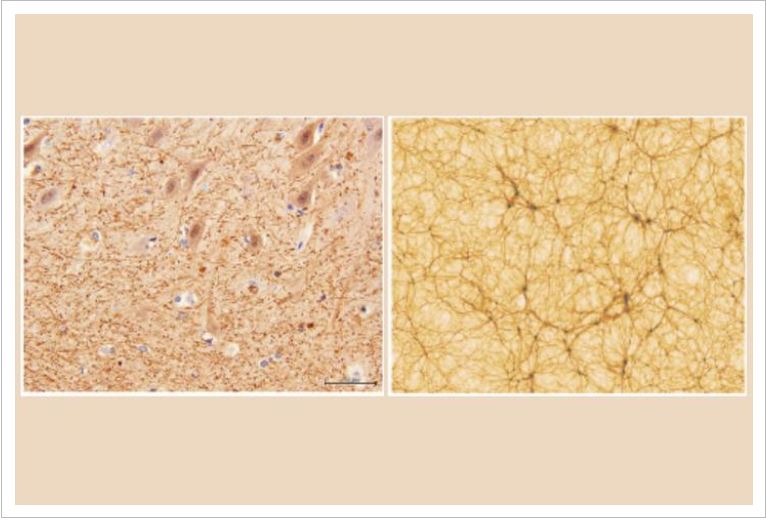博文
译文:新研究描绘出人脑和宇宙之间存在奇怪的结构相似性
||
Study Maps The Odd Structural Similarities Between The Human Brain And The Universe
新研究描绘出人脑和宇宙之间存在奇怪的结构相似性
MICHELLE STARR 17 NOVEMBER 2020
One fascinating quirk of the Universe is that shapes and patterns can be found in hugely different contexts: the Golden Spiral can be seen in the human cochlea and the shape of a spiral galaxy; the fractal geometry of veins echoed in the branching of lightning.
宇宙的一个迷人的怪异之处就是,在极度不同的背景中能发现形状和模式:黄金螺旋结构(the Golden Spiral)既可以在人类耳蜗中存在,也可以在螺旋星系中出现;静脉的分形几何形状和闪电显出的分支的形状。
In a bold new pilot study, an astrophysicist and a neurosurgeon have bumped it up a notch, using quantitative analysis to compare two of the most complex systems in nature: the neuronal network in the human brain and the cosmic network of galaxies in the Universe.
在一个大胆的新尝试性实验中,一位天体物理学家和一位神经外科医生把这种相似性提高了一个档次,他们利用定量分析来对比自然届中两个最复杂的系统:人脑的神经网络和宇宙中星系之间的宇宙网络。
It's actually not that peculiar a comparison. You may have seen an image that occasionally gets shared around, showing a human neuron and a simulated galaxy cluster, side-by-side; the two look startlingly similar.
这其实并不是一个奇特的对比。你或许偶尔之间早就看到过人们到处分享的一张图像,展示出一个人类神经元和一个模拟的星系簇并排在一起,两者看上去惊人的相似。

(Mark Miller/Virgo Consortium/Visual Complexity)
But there's a lot more to the human brain - and the Universe - than how it looks.
但是人类大脑和宇宙之间的关系远比看上去更为复杂。
So astrophysicist Franco Vazza of the University of Bologna in Italy and neurosurgeon Alberto Feletti of the University of Verona in Italy have spent the last few years investigating to determine if the similarities are more than skin-deep.
所以意大利博洛尼亚大学(the University of Bologna)的天体物理学家Franco Vazza和意大利维罗纳大学(the University of Verona)的神经外科医生Alberto Feletti在过去几年时间内进行了研究,以确定这些相似性是否只是表面上看起来那样的。
Writing in Nautilus Quarterly in 2017 they explained:
在2017年的《鹦鹉螺季刊》(Nautilus Quarterly)上他们解释道:
"Galaxies can group into enormous structures (called clusters, superclusters, and filaments) that stretch for hundreds of millions of light-years. The boundary between these structures and neighboring stretches of empty space called cosmic voids can be extremely complex.
“星系可以分组到巨大的结构之中(这些结构叫做簇、超级簇和细丝),这些结构可以延展达数亿光年。这些星系结构的边界和临近的空间被叫做宇宙间的虚空,这可以是极其复杂的。
Gravity accelerates matter at these boundaries to speeds of thousands of kilometers per second, creating shock waves and turbulence in intergalactic gases.
引力把这些边界间的物质加速到每秒数千公里的速度,在星系间的气体中创造出冲击波和湍流。
We have predicted that the void-filament boundary is one of the most complex volumes of the universe, as measured by the number of bits of information it takes to describe it.
我们已经预测,宇宙虚空和细丝的边界是我们宇宙中最复杂的东西之一,这是由描述它所用的信息的比特数来度量的。
This got us to thinking: Is it more complex than the brain?"
这就让我们想到:它比大脑更为复杂吗?”
The two types of structures differ in size by 27 orders of magnitude (that's a billion billion billion). But the team's results suggest that, while the physical processes that drive the structure of the Universe and the structure of the human brain are extremely different, they can result in similar levels of complexity and self-organisation, the researchers said.
这两个结构相差27个数量级(that's a billion billion billion可以数一下......)。但是,研究者说,该团队的研究结构暗示,虽然驱动宇宙结构和人脑结构的物理过程极为不同,但是它们可以导致相似的复杂水平和自组织。
The starting point was working out similarities between the two. The human cerebellum has around 69 billion neurons; the observable cosmic web contains over 100 billion galaxies. That's one.
开始的工作就是计算出两者之间的相似性。人类小脑大约有690亿个神经元,可见的宇宙之网包含1000亿个星系。这是一个方面。
Both systems are arranged in well-defined networks, with nodes (neurons in the brain, galaxies in the Universe) connected via filaments.
两个系统都被安置于良好定义的网络中,都有节点(大脑中是神经元,宇宙中是星系),都通过细丝连结。
Both neurons and galaxies have a typical scale radius that's only a fraction of the length of the filaments. And the flow of information and energy between nodes is only around 25 percent of the mass and energy content of each system.
神经元和星系都有一个典型的半径规模,即细丝的长度的一小部分。每一个系统中节点之间信息和能量的流动只占每个系统的质能组成的25%左右。
In addition, there are similarities between the composition of the brain and the composition of the Universe. The brain is around 77 percent water. The Universe is around 72 percent dark energy.
另外,在大脑的构成和宇宙的构成之间也有相似之处。大脑中有约77%的水。宇宙中有约72%的暗能量。
Both of these are apparently passive materials that permeate their respective system and play only an indirect role in their internal structures.
这两者都似乎是被动的物质,它们都弥漫于对应的系统,并且都只扮演内部结构之间间接的角色。
With these similarities defined, the team next undertook quantitative comparison of the two, based on images. They obtained slices of the human cerebellum and cortex at different magnifications, and compared them to simulations of the cosmic web.
定义了这些相似性,这个团队接下来对两者进行了基于图像的量化对比。他们获得了在不同放大率下的人类小脑和大脑皮层的切片,以与模拟出的宇宙之网进行对比。
What they were looking for were similarities in the matter density fluctuations between brains and the cosmic web. And they found that the relative distribution of fluctuations in the two systems was amazingly similar - although on much different scales.
他们所寻找的是两者在物质密度波动之间的相似处。他们发现,在两个系统中,物质密度的波动的相对分布惊人地相似——虽然是在极为不同的规模规模上。

A slice of cerebellum at 40x magnification (left) and simulated cosmic web at 300 light-years a side (right). (University of Bologna)
左边是40倍放大率下的小脑切片,右边是模拟的宇宙之网每一边延展300光年的情况下的样子
"We calculated the spectral density of both systems. This is a technique often employed in cosmology for studying the spatial distribution of galaxies," Vazza said.
“我们计算了两个系统的光谱密度(spectral density)。这是一种在宇宙学中常用的,用来研究星系空间分布的技术 ,”Vazza说。
"Our analysis showed that the distribution of the fluctuation within the cerebellum neuronal network on a scale from 1 micrometer to 0.1 millimeters follows the same progression of the distribution of matter in the cosmic web but, of course, on a larger scale that goes from 5 million to 500 million light-years."
“我们的分析表明,在小脑神经网络中,从1微米到0.1毫米的尺度上,物质密度波动的分布与,宇宙之网中物质的分布的级数是相同的,当然在更大的,从500万到5亿光年的尺度上。”
But that wasn't all.
但这还不是全部。
The team looked at other morphological features, such as the number of filaments connected to each node. The cosmic web, based on a sample of 3,800 to 4,700 nodes, had on average 3.8 to 4.1 connections per node. The human cortex, for a sample of 1,800 to 2,000 nodes, had an average of 4.6 to 5.4 connections per node.
该团队还研究了其他形态学上的特点,例如每个节点间连结的细丝的数目。对宇宙之网而言,基于3,800 to 4,700节点的样本来看,每个节点平均有3.8到4.1根细丝相连接。人类大脑皮层,在1800到2000节点的样本上看,每个节点平均有4.6到5.4个丝状连结。
In addition, both systems showed a tendency to cluster connections around central nodes. And both seem to have a similar information capacity.
另外,两个系统都表现出一种在中央节点的簇连结倾向。并且两者似乎有相似的信息容量。
A recent study suggests that the memory of the human brain is around 2.5 petabytes. Another recent study, by Vazza, suggests that the memory capacity required to store the complexity of the Universe is around 4.3 petabytes.
一项近期的研究暗示,人脑的记忆容量在2.5 PB(petabytes)。Vazza的另一项近期的研究,暗示,存储宇宙的复杂度所需要的记忆容量在4.3PB。
"Roughly speaking," the researchers wrote in 2017, "this similarity in memory capacity means that the entire body of information that is stored in a human brain (for instance, the entire life experience of a person) can also be encoded into the distribution of galaxies in our universe."
研究者在2017年写道,“粗略而言,”“这种记忆容量的相似性意味着,一个人脑中储存的总的信息量(例如,一个人的整个的一生的经历)也可以被编码成我们宇宙的星系的分布之中。”
That's not to say that the Universe is a brain, or capable of sentience. But it does hint that the laws that govern the growth of the structures of both could be the same.
这不是说宇宙是一个大脑,或者有知觉(sentience)。但是它确实暗示,统治这两者的结构生长的法则可能是同一个。
According to a 2012 paper based on simulations, the causal network representing the large-scale structure of spacetime in our accelerating universe is a power-law graph remarkably similar to the human brain.
根据2012年的一篇论文中的模拟,在我们加速的宇宙中代表大尺度的时空结构的因果网络,是一个幂律图(a power-law graph),这与人类大脑的惊人的相似。
Studies such as this one, by Vazza and Feletti, could pave the way to better understanding those laws.
像Vazza和Feletti的这类研究,可以为我们理解这些法则铺平道路。
"Once again, structural parameters have identified unexpected agreement levels. Probably, the connectivity within the two networks evolves following similar physical principles, despite the striking and obvious difference between the physical powers regulating galaxies and neurons," Feletti said.
Feletti说,“又一次,结构参数存在已被确定出的出乎意料的一致的水平。很可能,这两个网络中的连结遵循相似的物理原则而演化,尽管,在调节星系和神经元的物理之力方面是令人吃惊,且显而易见地不同的。”
"These two complex networks show more similarities than those shared between the cosmic web and a galaxy or a neuronal network and the inside of a neuronal body."
“这两个复杂的网络之间表现出更多的相似性,这要比,宇宙之网和星系之间,或者,一个神经网络和神经细胞内部中间的相似性大。”
The research has been published in Frontiers in Physics.
该研究发表在Frontiers in Physics上。
https://www.frontiersin.org/articles/10.3389/fphy.2020.525731/full
ps:版权属于原作者和机构,翻译仅作学习之用!
https://blog.sciencenet.cn/blog-2769946-1260671.html
上一篇:关于证明或否证所谓“本命年”的一点小思考
下一篇:译文:新量子力学实验表明:基本粒子和其属性或许可以分离